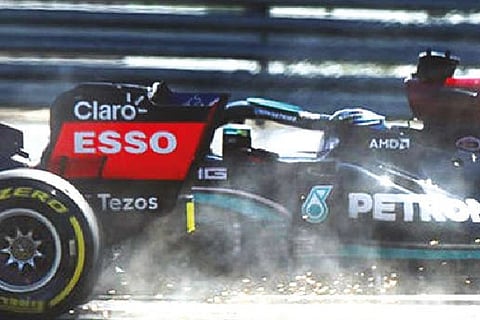

New York
Formula 1 is enjoying quite the season. Buoyed by the title fight between Max Verstappen and Lewis Hamilton, the success of Netflix’s show Drive to Survive and building off Liberty Media’s rebranding and marketing, motor sport’s most prestigious series is growing strongly. But at what price? The international courier service DHL, a major F1 sponsor, revealed that for the 2021 season to happen, it clocked up to 120,000 km to deliver cars, teams, broadcast and hospitality equipment, as well as fuel and tires. This is the equivalent of three trips around the world.
Just days after UN Secretary-General Antonio Guterres, speaking at the COP26 in Glasgow, reinforced the fact that the very existence of the world as we know it is threatened by humanity’s “addiction to fossil fuels,” the idea of flying teams of people to 21 countries to allow 22 1,000-horsepower cars drive around a circuit for an hour and a half seems beyond irresponsible.
Last year, F1 unveiled its climate strategy. This included a new engine that aims to be 100% sustainably fuelled and carbon-neutral by 2030, incentives for greener travel for fans, more sustainable materials, ultra-efficient logistics and offices, facilities and factories powered 100% by renewable energy. This all sounds promising, and given the sport’s history of developing technologies that have aided the progression of everyday cars, perhaps F1 deserves the benefit of the doubt. For all the talk of ultra-efficient logistics, the biggest contributor to the sport’s CO2 emissions, transportation, remains a concern. F1 revealed in a sustainability report that 45% of the 2018 season’s CO2 emissions, roughly 256,551 tons, came from the transportation of F1 teams and all their equipment.
Using data provided by the US Environmental Protection Agency to put those 256,551 tons of CO2 into context, that’s the greenhouse gas equivalent of 55,795 passenger vehicles being driven for one year. F1 said that since launching its climate strategy in November 2019 it has made “great headway in reducing the volume of equipment we send to races.” Last year, in response to the COVID-19 pandemic, F1 accelerated a two-year plan to deliver remote broadcast operations, condensing it into just eight weeks. By moving more technical equipment back to the UK, the amount of traveling staff sent to races was reduced by 36%, and freight sent to races was reduced by 34%. F1 said this saved 70 tons of freight being taken to every event, which across last season’s 17-race season equated to 1,190 tons of freight not being shipped. This season, with 22 races back on the schedule, it was expected that similar if not more reductions were made. Formula 1 said it was also investing in plans to upgrade its shipping containers, allowing it to transition from an older fleet of 747 airplanes to more fuel-efficient 777s. The move would also offer more flexibility in choosing lower-impact modes of transport such as rail, road and sea freight.
This, and planting trees to offset emissions, are positive steps, but are they enough? Can a sport whose global partners include Saudi Aramco, the world’s largest oil producer, and Emirates, the largest airline in the Middle East, do more?
And what about the emissions from business travel? In the F1’s 2018 sustainability report, 27.7% of the emissions came from business travel, defined as “all individuals air and ground transportation, as well as hotel impacts for all F1 teams employees and employees of major event partners.” F1 said it is “committed to reducing its carbon footprint across all areas of emissions, and is supported on this journey by our Commercial Partners.” Drivers and team principles are well aware the sport needs to change. Sebastian Vettel has repeatedly asked for F1 to do more when it comes to sustainability, and Lewis Hamilton’s long-standing commitment to environmental causes are to be applauded. But the most expensive traveling circus in sports must also deliver on its promise to dramatically change its act.
This article was provided by Deutsche Welle
Visit news.dtnext.in to explore our interactive epaper!
Download the DT Next app for more exciting features!
Click here for iOS
Click here for Android